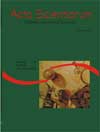The romantic architecture in Erico Verissimo’s short stories
Abstract
Considering that a compositional form makes an architectonic form (Bakhtin, 1990) which unifies and organizes the cognitive and aesthetic values of a worldview, the present paper intends to discuss how the final effect compositional form organizes the architecture of Erico Verissimo’s short stories first published in As mãos de meu filho (1942) and O ataque (1959), and afterwards collected - with the exception O ataque - under the title of Contos. Analyzing the corpus - consisting of the narratives As mãos de meu filho, O navio das sombras, Os devaneios do general, Sonata, Esquilos de outono and A ponte - we concluded that in all these texts the final effect narrative produces an epiphany of modern man’s alienated condition and gives architectonic form to a romantic worldview in crisis, because the conflict which happens between its utopian expression and the resigned and restitutionalist expressions is constantly rejected by the elaborate final effects.Downloads
Download data is not yet available.
Published
2008-07-02
How to Cite
Silva, M. L. e. (2008). The romantic architecture in Erico Verissimo’s short stories. Acta Scientiarum. Human and Social Sciences, 22, 75-85. https://doi.org/10.4025/actascihumansoc.v22i0.4116
Issue
Section
Literature and Linguistics
DECLARATION OF ORIGINALITY AND COPYRIGHTS
I Declare that current article is original and has not been submitted for publication, in part or in whole, to any other national or international journal.
The copyrights belong exclusively to the authors. Published content is licensed under Creative Commons Attribution 4.0 (CC BY 4.0) guidelines, which allows sharing (copy and distribution of the material in any medium or format) and adaptation (remix, transform, and build upon the material) for any purpose, even commercially, under the terms of attribution.
Read this link for further information on how to use CC BY 4.0 properly.























